 Japan, 1921. Aircraft Carrier
Japan, 1921. Aircraft CarrierWW2 IJN Aircraft Carriers:
Hōshō | Akagi | Kaga | Ryūjō | Sōryū | Hiryū | Shōkaku class | Zuihō class | Ryūhō | Hiyo class | Chitose class | Mizuho class* | Taihō | Shinano | Unryū class | Taiyo class | Kaiyo | Shinyo | Ibuki |The Hōshō, world’s first purpose-built aircraft carrier
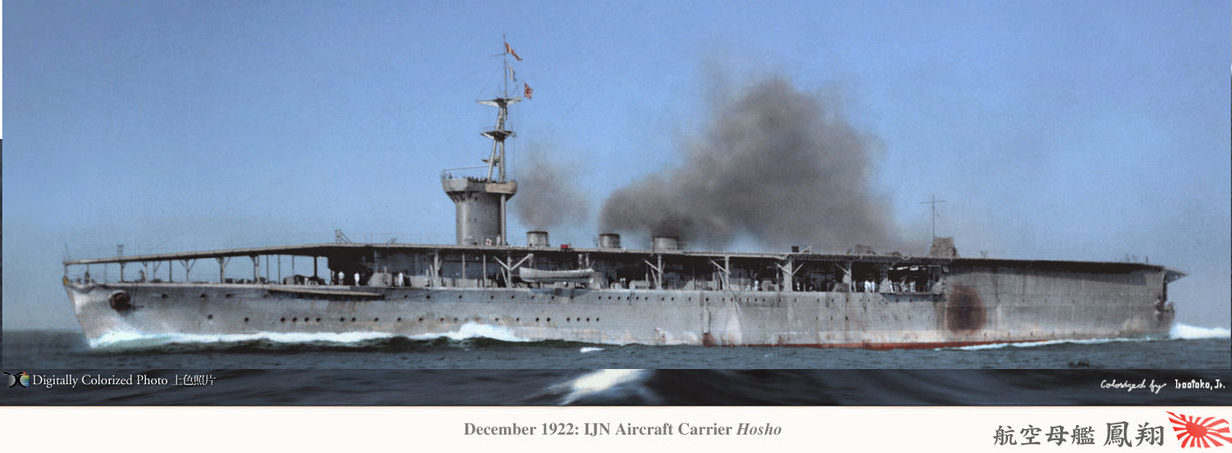
Hosho was the first Japanese aircraft carrier. And a historical landmark as the world’s first purpose-built aircraft carrier. An important precision as it is surprising that the United Kingdom was not into it first. Back in 1918, the ship was part of the “eight-six” fleet program. She was started AFTER HMS Hermes, but yet she was launched and completed before. However the Japanese went through some shortcuts: An existing ship, and British aid, plus no labor or material shortages.
Hosho was indeed originally the large oil tanker Hiryu, whose construction began in 1919. So the plans were redrawn from this, just after the Japanese high command, observing the success of the British Navy with the Furious and Argus, requisitioned this ship in 1920 to convert her. British aid was sought, and the latter sent the Semphill technical mission, which presided over the design work. The keel was laid down 16 December 1920. In 13 November 1921, so barely 11 months, Hosho was launched in this new configuration and was commissioned in December 1922.
At that time, the Japanese naval aviation, embryonic since only a few tests had been conducted, became an independent body of the army. The first naval fighters appeared, including the famous Mitsubishi 1MF1, the first of a long serie leading to the brilliant Zero in 1940. Hōshō mean “Phoenix flying”. The veteran of all Japanese “flat-tops” saw constant action from 1932 to 1945. She was one of the rare to survive WW2. She could have been preserved, but the Ministry of the Interior in 1946 preferred to have her recycled as they were other priorities at hand.

The launch of the “Phoenix flying” at Asano Shipbuilding Company, Tsurumi-ku, Yokohama in 1921. She was built and introduced into service in just two years (Dec.1920 -Dec.1922).
Design of the Hōshō
The Hosho was rather fast, since before in its old configuration, to follow the squadron, and its modest dimensions remained exploitable by the small devices of the time. She had a small command tower and a tripod mast, but these were removed in 1923 to achieve a pure “flush-deck”. She had six small funnels protruding to port and starboard, which had the distinction of being raised or lowered according to the use of the flying deck, so not to interfere with operations with smoke. She had no catapult, and the narrow deck served as a runway for only a few planes. These were of the land-based type and stored in the low hangar. However, she also carried and operated floatplanes.
General conception
The initial planning was to build a seaplane carrier like the HMS Campania. A ship that operated planes from a forward flying-off deck. However 32 aircraft were to be carried and the ship was to be defended by four low-angle 5.5 in guns (140 mm), and four standard 3-in AA guns. These plans were scrapped and all blueprints redrawn after reports from Japanese Royal Navy observers which observed the usefulness of using land-based aircraft instead.
The new requirements called for a close copy of HMS Furious when her rear flight deck was built in 1918. A new speed was defined, 30 knots (56 km/h; 35 mph) to be able to carry on with the battle fleet. This speed however, was later reduced to 25 knots (46 km/h; 29 mph) after reading reports after the war. She was fitted with a forward flight deck whereas the superstructure and funnels were moved amidships. A large hangar was built aft. Indeed the forward part of the flying deck was hanging over an utility deck with boats, artillery, and anchor heavy-duty gear. The Japanese observers reported landing trials on Furious and Argus, bringing more modifications carried on Hōshō’s own flight deck design in April 1919.
The superstructure was eventually completely removed while the funnels were moved further to the side to create a perfectly unobstructed flight deck. She was reclassified by then as an aircraft carrier. Her hull was based on a large cruiser, and outside a full superstructure, she was given a small island with an essential bridge controls, a bit like on a submarine, but with also the flight operations control center. Her three funnels on the starboard side were small enough to be mated to large swivels in order to lie horizontally during flight operations. She was in her final version 168.25 meters long (552 ft) by only 17.98 meters (59 ft) in width (beam) while the flying deck was a bit larger at 22.62 meters (74 ft 3 in). That was about the span of two fighters side to side.
At that time, it was normal as to allow planes to be stacked at the rear of the ship and having all the space forward necessary for the planes to take off with a little help: Their wheels were blocked by personal until the engine power was sufficient, and then the shims were retired and the plane “jumped” in speed quite quickly, enough to be flying at the end of the deck. The Hōshō was armed like a light cruiser, but with a superior tonnage (9,494 long tons (9,646 t) at normal load.), and received no protection or armor. She already relied on an escort to operate safely.
Armament
It was limited to six guns: Four single 14 cm/50 3rd Year Type guns and two single 8 cm/40 3rd Year Type AA guns.
The former were standard models found on the “three stacker”, light cruisers of the IJN. Two were placed on each side, forward and aft. The former had a firing arc of 150°, and were able to fire forward and the aft ones 120°. Their shells were 38-kilogram (84 lb), flying at 850 m/s (2,800 ft/s) muzzle velocity. Rate of fire was about 6 to 10 rpm. Maximal range at 35° angle was 19,750 m (21,600 yd).
This was heavy for an aircraft carrier but as the concept was brand new and since aviation seemed not a worthy defensive scheme, the new ships types doctrine included self-defence. The 40-caliber 8 cm/40 3rd Year Type guns were quite interesting. Their mounts were fixed on elevator so they can be lowered and not obstruct the deck operations. Placed just forward of the rear elevator they fired a 6-kgs (12.5–13.2 lb) shell at 680 m/s, up to 10,800 meters (11,800 yd) at 45° and with a 7500 m ceiling at 13-20 rpm. There was a small tripod mast to mount the ship’s fire-control system just behind the island.
The Type 96 autocannons existed in single and twin mounts (singles only on Hosho), firing .25-kilogram (0.55 lb) projectiles at 900 m/s (3,000 ft/s). At 50° angle, range was 7,500 meters (8,202 yd), ceiling 5,500 meters (18,000 ft). Loading was using 15-round magazines and required two loaders constantly manipulating these, reducing the rate of fire to 110-120 rpm.
Powerplant
Hōshō two Parsons geared turbine fed by eight Type B water-tube Kampon boilers, four oil-fired and the other coal/fuel mixed-fired. They worked at 18.3 kg/cm2 or 1,790 kPa; 260 psi pressure, at 138 °C. This powerplant was rated for 30,000 shaft horsepower (22,000 kW). The turbines were connected to two propeller shafts. Designed speed was 25 knots, 26.66 knots (49.37 km/h; 30.68 mph) obtained in trials, 30 November 1922. 2,700 long tons (2,700 t) of fuel oil were carried plus 940 long tons (960 t) of coal. This was a lot, making for an excellent autonomy and very large radius of action, 8,680 nautical miles (16,080 km; 9,990 mi) at 12 knots (22 km/h; 14 mph).
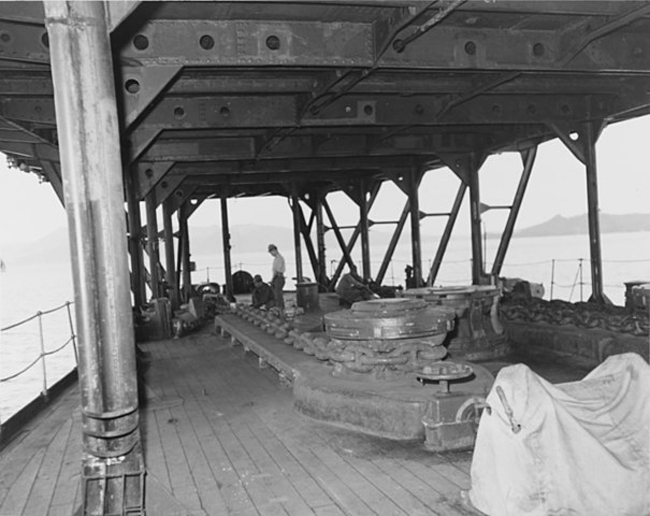
Onboard aviation
Flight operation equipment
The flight deck overhang was mostly at the front, on both sides over the prow, but the forward end was sloped down at an angle of −5° to make the planes plunge and accelerate. There was no catapult, but for arresting landing planes, no satisfying solution either. The Japanese went through the evaluation of no less than fifteen different types of landing equipment. Eventually, the British longitudinal wire system was adopted. Wind gusts were quite a problem for such light planes, and in addition, pilots had to deal with rolling in bad weather. To increase stability an American-built Sperry gyrostabilizer was installed. Not reliable at first, but Japanese training improved and the system was proven.
Onboard aviation
The Hōshō was planned to carry 32 planes, but this was reduced to 23 in storage, whereas in practice she carried only 15. But she was the IJN aircraft carrier which tested all models developed for the naval aviation branch, starting in 1923:
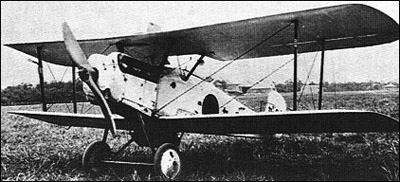 –Mitsubishi 1MF1 (1923): Designed by a British engineer, Herbert Smith, from Sopwith. He went in Japan in 1921 to study the need of the IJN for its future aircraft carriers and the Hosho, and created a local prototype using an Hispano-Mistubishi engine rated for 300 hp. The 1MF1 was tested and accepted in service in 1923. 128 were delivered until 1928, which served on the Hosho and the other first IJN carriers. There were seven sub-variant. This early model was declared obsolete in 1929 but formed a generation of pilots.
–Mitsubishi 1MF1 (1923): Designed by a British engineer, Herbert Smith, from Sopwith. He went in Japan in 1921 to study the need of the IJN for its future aircraft carriers and the Hosho, and created a local prototype using an Hispano-Mistubishi engine rated for 300 hp. The 1MF1 was tested and accepted in service in 1923. 128 were delivered until 1928, which served on the Hosho and the other first IJN carriers. There were seven sub-variant. This early model was declared obsolete in 1929 but formed a generation of pilots.
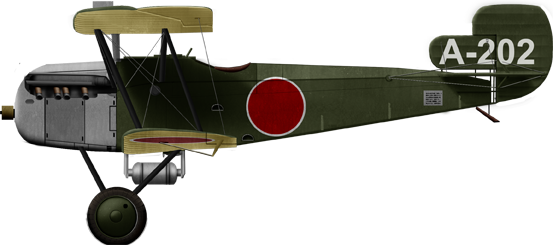
1MF3, IJN, Hosho. The ‘A’ carrier identification code was used until 1926.
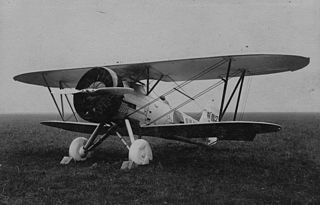 -Nakajima A1N/A2N/A3N/A4N (1925-41):
-Nakajima A1N/A2N/A3N/A4N (1925-41):
The Nakajima A1N was single-engined biplane fighter of mixed construction with a radial engine which replaced the 1MF1. About 150 A1N, then 100 A2N and then 66 A3N were delivered until 1936. Heavily used in the Sino-Japanese war in 1937-39. Minoru Genda promoted the naval aviation by using these all around the world, called “Genda’s Flying Circus”. A two-seat trainer was built until 1939, but by 1940 the type was obsolete and relegated to second line duties and remote outposts. The last A4N (1935) remained in service until 1941 in China. By that time Mitsubishi was again the main supplier of fighters for the IJN between the A5M and A6M.

Nakajima A1N-1, IJN Hosho 1926
It’s only in 1920 that Mitsubishi JuKogyo KK separated the aviation branch from the rest of the company. However the company started early producing licence-built Farmans and Sopwith.
Nakajima Hikogi KK was funded in December 1917. After copying western models they will create in 1931 the first purely national fighter.
Kawasaki Kokuki Kogyo KK was funded in 1918 as a subsidiary from the main company dedicated to heavy industry. Aichi started in 1920 and Tachikawa 1928 while Kawanishi specialized in floatpanes for the Navy since 1920.
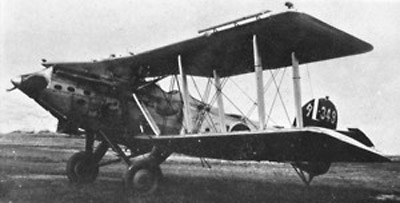 -Mitsubishi B2M (1932):
-Mitsubishi B2M (1932):
This 1932 torpedo-bomber was designed from British plans, made by Blackburn, which had a significant experience in the field of carrier-borne naval torpedo planes. It was given a 600 hp hispano-Mitsubishi V12, weighted 3600 kgs and carrier two, the pilot and bomber/gunner/observer; The B2M carried either a single 457 mm torpedo or 800 kgs of bombs. Several prototypes were made and tested in 1929-1931, with trials in UK and Japan. Production started in 1932 and lasted until 1935, with a total of 108 planes. Two variants appeared, the B2M1 and B2M2, but the plane was relegated from 1936 to second-rate coastal bases and obsolete by 1939, replaced by modern all-metal cantilever monoplanes.
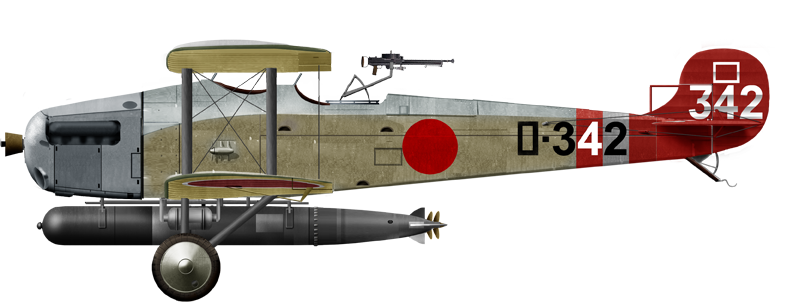
Mitsubishi B1M-1 on board IJN Hosho, 1926. The Mitsubishi B1M (1924, 443 built) became the first successful torpedo bomber of the IJN, by chief designer Herbert Smith and his team, formerly from Sopwith. It lasted more than intended, until 1936 at that stage already replaced by the B2M Type 89.
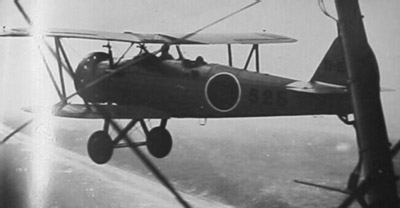 -Yokosuka K5Y (1933):
-Yokosuka K5Y (1933):
The most prolific training biplane of the Imperial Japanese Navy, with some 5770 built from 1933 when it was first introduced. A classic two-seat biplane with twin commands, it had the same radial engine as the K3M and was agile, very stable and very reliable. It was still in service when WW2 broke out, produced until 1945 and was used also for observation, liaison and many other tasks. A familiar sight in the Pacific and China.
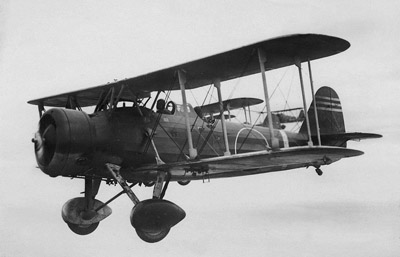 –Aichi D1A (1934):
–Aichi D1A (1934):
The most prolific dive bomber in the IJN. First introduced on the Akagi, Kaga and Ryujo. Powered by a radial Nakajima Kotobuki 580 hp it was derived from the German Heinkel 88 and extremely robust biplane using mostly metal. 590 were in service until replaced by the famous D3A “Val” of 1940, from the same company. The kokutais 12, 13, 14, et 15 were equipped with this plane.
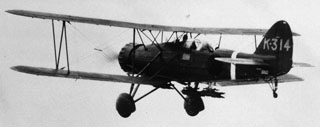 -Yokosuka B4Y (1936): The last IJN bomber biplane, it first flew in 1935 and was produced from 1936 to 1939 and retired only in 1943 after being posted gradually to secondary theaters of operation, like distant Chinese outposts. 205 were delivered total, and the B4Y1 was widespread with the Akagi, Hōshō, Kaga, Ryūjō, Sōryū, and Unyō. They were propelled by a 626 kW (840 hp) Nakajima Hikari-2 nine-cylinder air-cooled radial engine and carried either a 800 kg (1,764 lb) torpedo, or 500 kg (1,102 lb) of bombs.
-Yokosuka B4Y (1936): The last IJN bomber biplane, it first flew in 1935 and was produced from 1936 to 1939 and retired only in 1943 after being posted gradually to secondary theaters of operation, like distant Chinese outposts. 205 were delivered total, and the B4Y1 was widespread with the Akagi, Hōshō, Kaga, Ryūjō, Sōryū, and Unyō. They were propelled by a 626 kW (840 hp) Nakajima Hikari-2 nine-cylinder air-cooled radial engine and carried either a 800 kg (1,764 lb) torpedo, or 500 kg (1,102 lb) of bombs.
-Mitsubishi K3M (1930):
A 1930 training aircraft, with an Hitachi-Amakaze radial engine, and used for training. 624 were built. Landing and taking off from aircraft carriers were part of this training, but most operated from land. They could carry and instructor and three students and an army version also existed.
The Hōshō at war – career 1923-45
The first Japanese aircraft carrier was completed at Yokosuka Naval Arsenal, starting on 10 January 1922 but ending in March 1922 as first planned. However, this was delayed by repeated design changes, plus delayed deliveries of equipment, until December 1922. However there were no planes onboard until 1924 with the delivery of the Mitsubishi 1MF1, and aircrews asked for changes that were applied between 6 June to 20 August 1924.
The biggest changes, as said above, were the removal of the island, tripod mast, and aircraft crane, while the forward end of the flight deck was made horizontal. At last, the aircraft carrier was assigned to the 1st Fleet until 15 November 1924. In 1925 further modifications were applied, like a crash barrier net aft of the forward elevator, hydraulically erected in three seconds. Hōshō became indeed in her early years, the prototype for all future IJN aircraft carriers. She was mainly used to train pilots and aircrews and test new equipment and procedures. She helped define new types of arresting gear and optical landing aids. She joined at last the First Carrier Division with Akagi on 1 April 1928.
Shanghai incident
Together with Akagi and Kaga of the First Carrier Division, Hōshō was sent to China during the Shanghai Incident in January 1932. Integrated as part of the 3rd fleet she sailed to the mouth of the Yangtze River on 1 February 1932, her fighters seeing action on 5 February when escorting two attack aircraft, duelling with nine Chinese fighters. Some of her aircraft also operated from Kunda Airfield for the IJA. They concentrating on attacking Chinese airfields at Hangzhou and Suzhou. On 26 February, Hosho’s fighters escorted bombers from Akagi, and shot down two Chinese fighters. On 20 March, Hosho departed to join the combined fleet as peace was signed.

1935 refit
She was attached with the IJN Fourth Fleet when an incident broke out when she was participating in the 1935 fleet manoeuvers. Caught in a typhoon on 23 September, the aircraft carrier was badly damaged, as the forward flight deck collapsed. She returned to Yokosuka for repairs. while in dockyard from 22 November 1935 to 31 March 1936, some modifications were applied. After the loss of the Tomozuru because of stability issues, she received extra keels for stability while the flying deck was reinforced, the old AA guns were replaced by six twin 13.2 mm Type 93 Hotchkiss mounts, the aircraft crane and the upper deck aviation fuel tanks were removed while the funnels were stuck in a horizontal position (the tilting mechanism was removed). The forward hangar and bridge sides and hull were also considerably reinforced. After all these changes, her metacentric height was down to 1.11 meters (3 ft 8 in), which reduced roll and improved pilot’s landing and flying off operations considerably.

The Sino-Japanese war
Hōshō supported land operations with the Third Fleet, Ryūjō, and Kaga, around Shanghai. By then she operated Nakajima A2N fighters, which shot down one Chinese Martin B-10 heavy bomber. On leave by September to refuel, she sailed to the South China coast, beginning operations near Canton on 21 September. Her fighters escorted bombers razing the airfields at Tienho and Paiyun. Six Chinese aircraft were shot down, however, five fighters ran out of fuel and ditch in the sea. Hōshō and Ryūjō bombing raids went on until the end of September and both ships returned to Shanghai on 3 October. The air group was transferred to Kunda airfield or extra range and before departing to Japan, the air group was taken in charge by Ryūjō.
By 1937 many new modern aircraft carriers entered service or were about to, and Hōshō was placed in reserve by December 1937. However she was in drydock for a last refit, her aircraft elevators being enlarged for the new generation of IJN planes in 1939 and in August she started a new carrier as a home waters training carrier. She however also participated in major engagement as a supply carrier for A4N1 fighters and B4Y1 torpedo bombers. By 1940 it was clear she could not operate the Mitsubishi A6M Zero, Aichi D3A “Val”, or Nakajima B5N “Kate” and therefore she returned to her previous training duty.
The pacific campaign
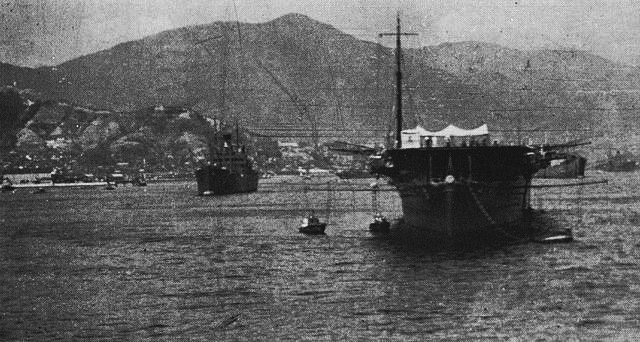
In mid-1941 she served with the Third Carrier Division assigned, 1st Fleet (Vice Admiral Shirō Takasu) and Zuiho. She escorted the main battle fleet, counting the Nagato, Mutsu, Fusō, Yamashiro, Ise, and Hyūga, and provided distant cover to the attack fleet on 7 December 1941. Hōshō was separated from the main fleet because of radio silence but made it to homeland at Kure on December, 12. She was also in action on 29 May 1942 at Midway, also providing cover for the Yamato, Nagato, and Mutsu, although her planes were obsolete, just eight obsolete Yokosuka B4Y. She was posted 556 km behind the carrier striking force. Her aircraft however guided Nagumo crippled fleet back to the main battle line for protection before returning home. Two of her pilots filmed the burning Hiryū. After her return to Hashirajima anchorage on 14 June, she was transferred to the training fleet, also called Mobile Force Training Force. The planes she operated only made training landings and were land-based.
1944 modernisation
By that date, she was indeed devoid of any planes, relegated to secondary duties. Her initial armament was increased from two 76 mm AA cannons, two 7.7mm machine guns plus eight 25 mm in 1941, to 8 other 25 mm and still 11 aircraft on board. In January 1944, she was reassigned to the 12th Air Fleet (Combined Fleet), while still used for training, and was sent to a drydock for extensive modifications: The flight deck was lengthened by 6m, reaching the entire length of the hull, and receiving a new arresting gear and a new crash barrier. She saw also her old 140 mm battery removed and twenty 25 mm AA guns fitted instead. She was unstable by then and preserved to home waters, but flewing the new Nakajima B6N “Jill” and the Yokosuka D4Y “Judy” bombers.
She remained away from the war zones, survived and served as a repatriation vessel for prisoners and Japanese garrisons isolated from the Pacific in 1946-47, before being striken, sold and delivered to the shipbreakers.
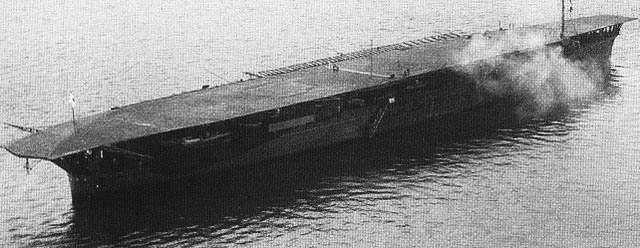
Hosho after her 1944 refit
Specifications
Displacement: 7,470 long tons standard, 9,494 long tons normal
Dimensions: 168.25 m (552 ft) x Beam 17.98 m (59 ft) x Draught 6.17 m (20 ft 3 in)
Machines: 2 shaft Kampon geared steam turbines, 8 Ro gô small-tube boilers
Maximum speed 25 knots (46 km/h; 29 mph)
Range: 8,680 nmi (16,080 km; 9,990 mi) at 12 knots (22 km/h; 14 mph)
Armament: 4 x 140 mm, 8 x 25 mm AA, 2 x 7.7 mmn, 15-21 aircraft
Crew: 512-550
Sources/ Read more
https://en.wikipedia.org/wiki/Japanese_aircraft_carrier_H%C5%8Dsh%C5%8D
Conway’s all the worlds fighting ships 1906-1921
Conway’s all the worlds fighting ships 1922-1947
http://www.combinedfleet.com/ships/hosho
https://www.militaryfactory.com/ships/detail.asp?ship_id=ijn-hosho-aircraft-carrier

Author’s illustration of the Hosho in 1941

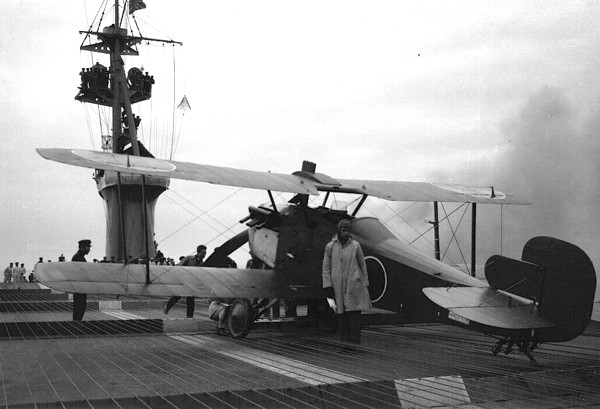
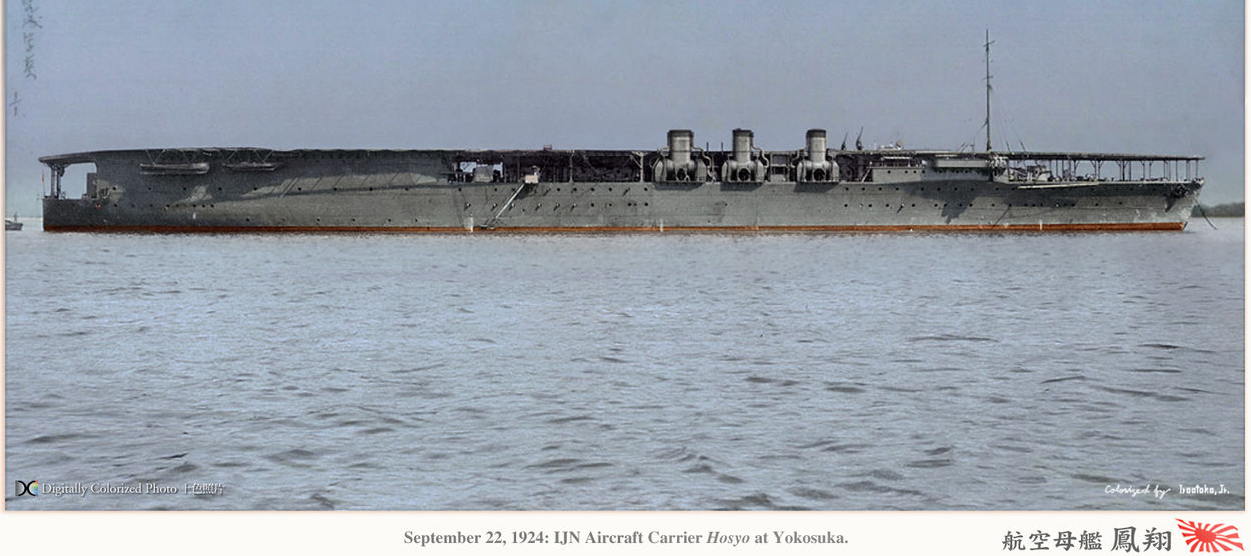
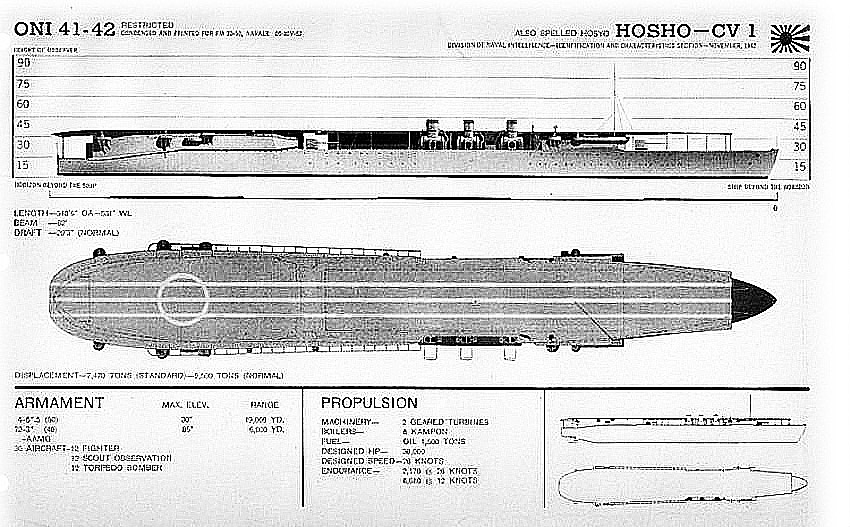
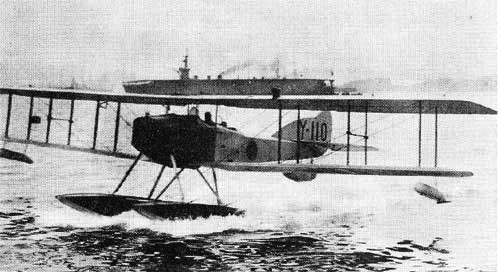
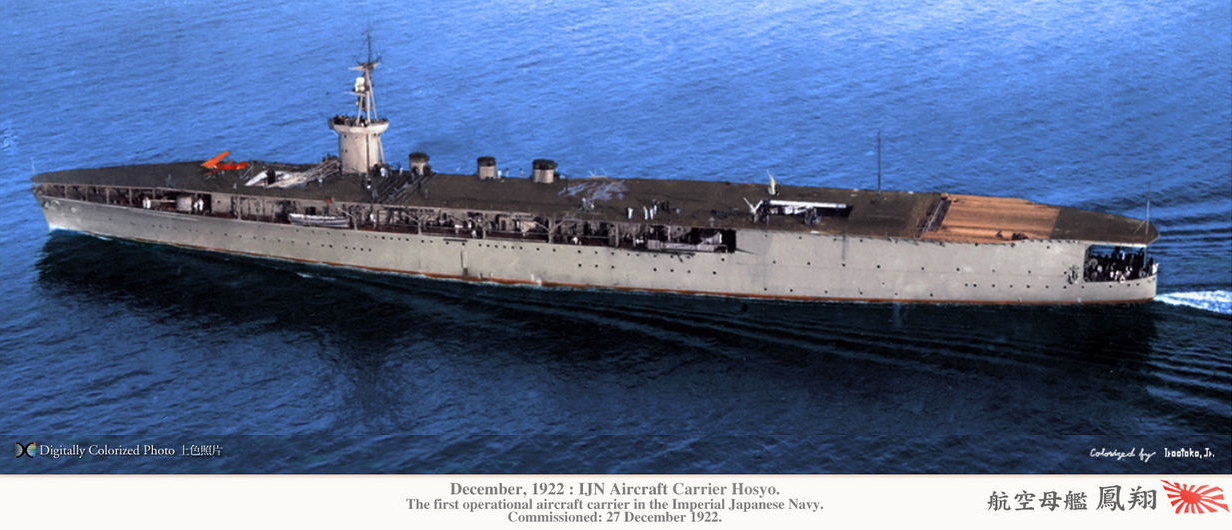
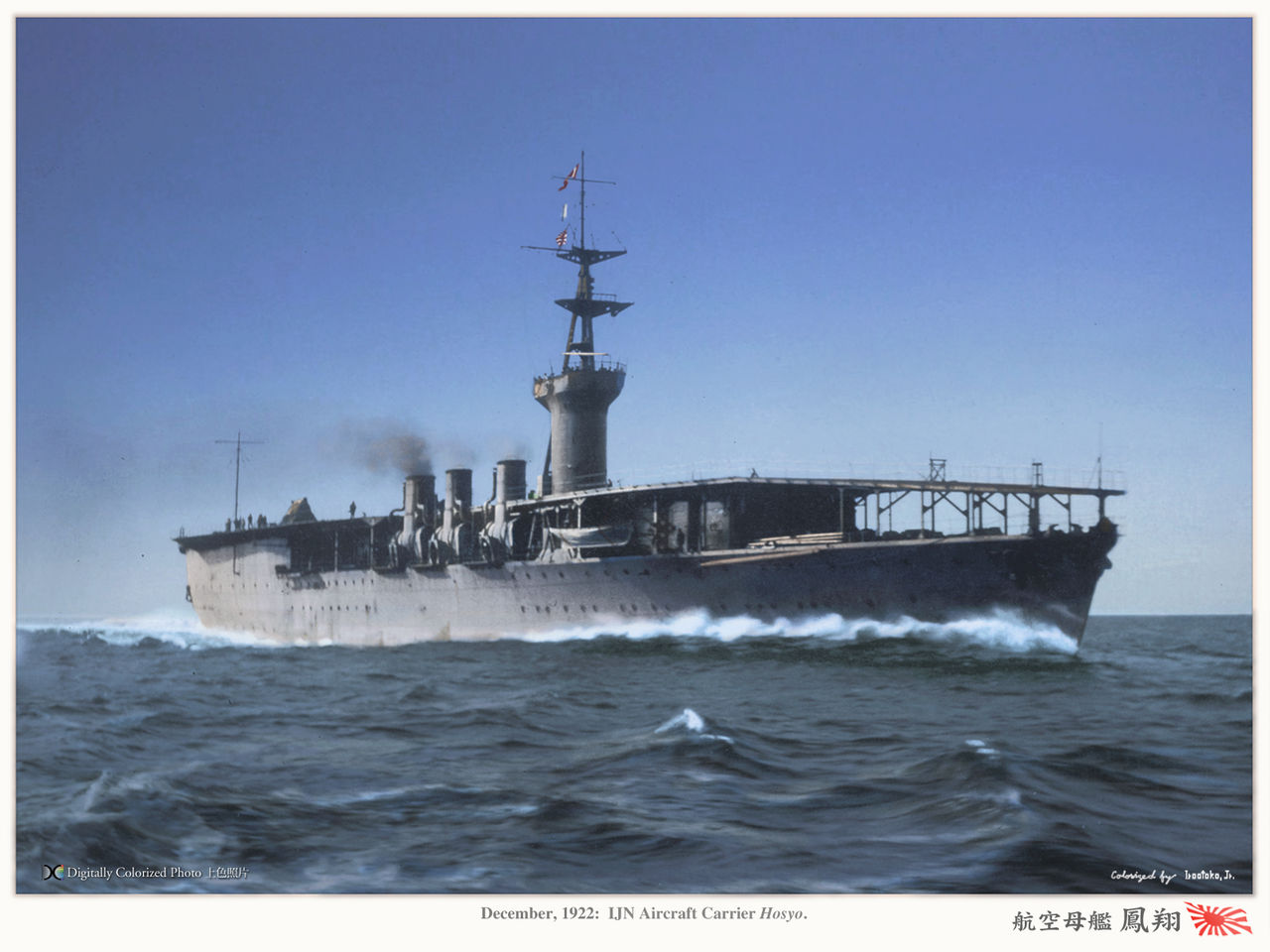
 Latest Facebook Entry -
Latest Facebook Entry -  X(Tweeter) Naval Encyclopedia's deck archive
X(Tweeter) Naval Encyclopedia's deck archive Instagram (@navalencyc)
Instagram (@navalencyc)





 French Navy
French Navy Royal Navy
Royal Navy Russian Navy
Russian Navy Armada Espanola
Armada Espanola Austrian Navy
Austrian Navy K.u.K. Kriegsmarine
K.u.K. Kriegsmarine Dansk Marine
Dansk Marine Nautiko Hellenon
Nautiko Hellenon Koninklije Marine 1870
Koninklije Marine 1870 Marinha do Brasil
Marinha do Brasil Osmanlı Donanması
Osmanlı Donanması Marina Do Peru
Marina Do Peru Marinha do Portugal
Marinha do Portugal Regia Marina 1870
Regia Marina 1870 Nihhon Kaigun 1870
Nihhon Kaigun 1870 Preußische Marine 1870
Preußische Marine 1870 Russkiy Flot 1870
Russkiy Flot 1870 Svenska marinen
Svenska marinen Søværnet
Søværnet Union Navy
Union Navy Confederate Navy
Confederate Navy Armada de Argentina
Armada de Argentina Imperial Chinese Navy
Imperial Chinese Navy Marinha do Portugal
Marinha do Portugal Mexico
Mexico Kaiserliche Marine
Kaiserliche Marine 1898 US Navy
1898 US Navy Sovietskiy Flot
Sovietskiy Flot Royal Canadian Navy
Royal Canadian Navy Royal Australian Navy
Royal Australian Navy RNZN Fleet
RNZN Fleet Chinese Navy 1937
Chinese Navy 1937 Kriegsmarine
Kriegsmarine Chilean Navy
Chilean Navy Danish Navy
Danish Navy Finnish Navy
Finnish Navy Hellenic Navy
Hellenic Navy Polish Navy
Polish Navy Romanian Navy
Romanian Navy Turkish Navy
Turkish Navy Royal Yugoslav Navy
Royal Yugoslav Navy Royal Thai Navy
Royal Thai Navy Minor Navies
Minor Navies Albania
Albania Austria
Austria Belgium
Belgium Columbia
Columbia Costa Rica
Costa Rica Cuba
Cuba Czechoslovakia
Czechoslovakia Dominican Republic
Dominican Republic Haiti
Haiti Hungary
Hungary Honduras
Honduras Estonia
Estonia Iceland
Iceland Eire
Eire Equador
Equador Iran
Iran Iraq
Iraq Latvia
Latvia Liberia
Liberia Lithuania
Lithuania Mandchukuo
Mandchukuo Morocco
Morocco Nicaragua
Nicaragua Persia
Persia San Salvador
San Salvador Sarawak
Sarawak Uruguay
Uruguay Venezuela
Venezuela Zanzibar
Zanzibar Warsaw Pact Navies
Warsaw Pact Navies Bulgaria
Bulgaria Hungary
Hungary

 Bundesmarine
Bundesmarine Dutch Navy
Dutch Navy Hellenic Navy
Hellenic Navy Marina Militare
Marina Militare Yugoslav Navy
Yugoslav Navy Chinese Navy
Chinese Navy Indian Navy
Indian Navy Indonesian Navy
Indonesian Navy JMSDF
JMSDF North Korean Navy
North Korean Navy Pakistani Navy
Pakistani Navy Philippines Navy
Philippines Navy ROKN
ROKN Rep. of Singapore Navy
Rep. of Singapore Navy Taiwanese Navy
Taiwanese Navy IDF Navy
IDF Navy Saudi Navy
Saudi Navy Royal New Zealand Navy
Royal New Zealand Navy Egyptian Navy
Egyptian Navy South African Navy
South African Navy






























 Ukrainian Navy
Ukrainian Navy dbodesign
dbodesign
Where did the information of the Aichi D1A come from? I looked around the internet to find evidence that it served on the Hosho. So far, I found that the Hosho only served torpedo bombers and fighters only through its career.
Hello Brandon,
Did i mentioned the D1A served onboard the Hosho ? The passage states “First introduced on the Akagi, Kaga and Ryujo”. Perhaps it confused you but i was making an introduction to IJN carrier-borne planes in general, not specifically to the Hosho. It is not improbable that some puncually landed or took off the the Hosho during some operations, but there was indeed no active squadron of D1As onboard.
In the future these will be relocated and expanded in a dedicated post about WW2 IJN carrier-borne aviation, and there is an upcoming post on IJN carriers as a whole.
Cheers !